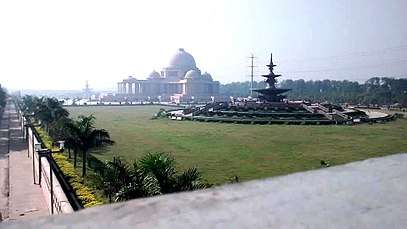Noida
Noida, short for New Okhla Industrial Development Authority, is a planned city[4] located in Gautam Buddh Nagar district of the Indian state of Uttar Pradesh. It is a satellite city of Delhi and is a part of the National Capital Region of India. As per provisional reports of Census of India, the population of Noida in 2011 was 642,381.[5] The city is managed by New Okhla Industrial Development Authority (NOIDA).[6] The district's administrative headquarters are in the nearby city of Greater Noida.
Noida | |
|---|---|
| New Okhla Industrial Development Authority | |
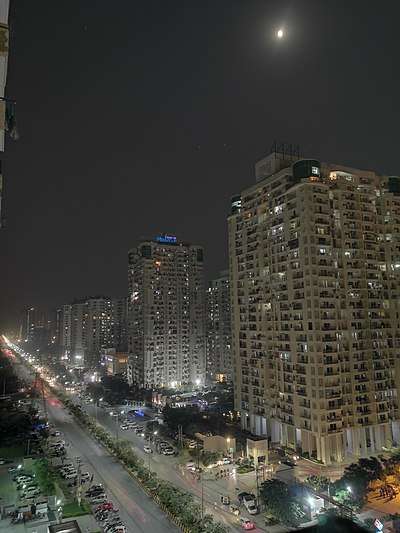 Sector 78 skyline | |
| Coordinates: 28.57°N 77.32°E | |
| Country | |
| State | Uttar Pradesh |
| Division | Meerut |
| District | Gautam Buddh Nagar |
| Established | 17 April 1976 |
| Government | |
| • Type | Government of Uttar Pradesh |
| • Body | Noida Authority |
| • Chairman, Noida Authority | Alok Tandon, (IAS) |
| • CEO, Noida Authority | Ritu Maheshwari, (IAS) |
| • Commissioner, Meerut Division | Aneeta Meshram, (IAS) |
| • District Magistrate and Collector | Suhas Lalinakere Yathiraj,[1] (IAS) |
| • Commissioner of Police | Alok Singh, (IPS) |
| Area | |
| • Total | 203 km2 (78 sq mi) |
| Elevation | 200 m (700 ft) |
| Population (2011)[2] | |
| • Total | 637,272 |
| • Rank | 66th |
| • Density | 2,463/km2 (6,380/sq mi) |
| Language | |
| • Official | Hindi[3] |
| • Additional official | Urdu[3] |
| Time zone | UTC+5:30 (IST) |
| PIN | 201301 to 201307 |
| Telephone code | 0120 |
| Vehicle registration | UP-16 |
| Lok Sabha Constituency | Gautam Buddh Nagar |
| Website | Noida Authority |
The city is a part of the Noida (Vidhan Sabha) constituency and Gautam Buddha Nagar (Lok Sabha) constituency. Minister of State for Culture and Tourism Mahesh Sharma is the present Lok Sabha MP of Gautam Buddha Nagar, while Pankaj Singh is the present MLA of Noida.[7][8]
Noida was ranked as the Best City in Uttar Pradesh and the Best City in Housing in all of India in "Best City Awards" conducted by ABP News in 2015.[9][10] Noida replaced Mumbai as the second-best realty destination, according to an analyst report.[11] Roads in Noida are lined by trees and it is considered to be India's greenest city with nearly 50% green cover, the highest of any city in India.[12][13]
History
Noida came into administrative existence on 17 April 1976 and celebrates 17 April as "Noida Day". It was set up as part of an urbanisation thrust during the controversial Emergency period (1975–1977). The city was created under the UP Industrial Area Development Act, 1976 by the initiatives of Sanjay Gandhi.[14] The city has the highest per capita income in the whole National Capital Region. Noida is classified as a special economic zone (SEZ).[15] The Noida Authority is among the richest civic bodies in the country.[16]
Geography
Noida is located in the Gautam Buddh Nagar district of Uttar Pradesh state India. Noida is about 25 kilometres (16 mi) southeast of New Delhi, 20 kilometres (12 mi) northwest of the district headquarters - Greater Noida and 457 kilometres (284 mi) northwest of the state capital, Lucknow. It is bound on the west and southwest by the Yamuna River, on the north and northwest by the city of Delhi, on the northeast by the cities of Delhi and Ghaziabad on the north-east, east and south-east by the Hindon River. Noida falls under the catchment area of the Yamuna River, and is located on the old river bed. The soil is rich and loamy.
| Geographical Area | 1442 Sq. km. |
| Population | 1105290, 600950(M), 504340 (F) |
| Literate | 627930, 402230(M),225700 (F) |
| Tehsils | 3 |
| Development Blocks | 4 |
| Nyay Panchayat | 38 |
| Gram Sabha | 243 |
| Inhabited Village | 343 |
| Inhabited Village | 30 |
| Towns | 8 |
| Source | http://gbnagar.nic.in/ |
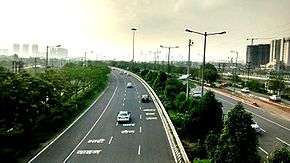
Demographics
As per provisional data of 2011 census, Noida had a population of 642,381 out of which the male population was 352,577 and the female population was 289,804. The literacy rate was 88.58 percent. Male literacy was 92.90% and female literacy was 83.28%.[5]
There are people of almost all major religions, but the majority practice Hinduism. Many famous Hindu temples are located in the city, some of the more famous ones are the Hanuman temple in Sector 22, the Kalibari Temple in Sector 26, the ISKCON temple in Sector 33, Shree Jagannath Temple in Sector 34, Sai Baba Temple in Sector 61, Shiv Mandir in Sector 31, Shri Ram Mandir in Sector 36 and the Kuti Temple at Sec 163 Mohiyapur. A Shia Jama Masjid in Sector 50 and St. Gregorios Indian Orthodox Church in Sector 51, Mar Thoma Church in Sector 50 and St. Mary's Catholic Church in Sector 34 are also well known.
Administration
Authority
The city's infrastructure is looked after by the NOIDA Authority, a statutory authority set-up under Uttar Pradesh Industrial Area Development Act, 1976.[14] Authority's head is its Chairman, who is an IAS officer, the authority's daily matters, however, are looked after by its CEO, who is also an IAS officer. NOIDA Authority comes under the Infrastructure and Industrial Development Department of Uttar Pradesh Government. The Chairman of NOIDA Authority is Alok Tandon and CEO is Ritu Maheshwari.[18][19]
General Administration
The Gautam Budh Nagar district is a part of Meerut Division, headed by the Divisional Commissioner, who is an IAS officer of high seniority, the Commissioner is the head of local government institutions (including Municipal Corporations) in the division, is in-charge of infrastructure development in his division, and is also responsible for maintaining law and order in the division.[20][21][22][23][24] The District Magistrate, hence, reports to the Divisional Commissioner of Meerut. The current Divisional Commissioner of Meerut is Anita C. Meshram (IAS).[25]
Gautam Budh Nagar district administration is headed by the District Magistrate (DM) of Gautam Budh Nagar, who is an IAS officer. The DM is in charge of property records and revenue collection for the central government and oversee the national elections held in the city.[20][26][27][28][29]
The District Magistrate is assisted by one Chief Development Officer, three (3) Additional District Magistrates/ ADM (Executive, Finance & Revenue and Law & Order), and one City Magistrate. The district has divided into three Sub-divisions named Noida Sadar, Dadri and Jewar each headed by a Sub-Divisional Magistrate (SDM) who reports to the District Magistrate. The current DM of Gautam Buddha Nagar (Noida) since 30 March 2020 is Suhas Lalinakere Yathiraj (IAS).
Law Enforcement
Until January 2020, Gautam Budh Nagar district used to come under Meerut Police zone and Meerut Police range of Uttar Pradesh Police. Meerut zone is headed by an IPS officer in the rank of Additional Director General of Police (Additional DGP), whereas Meerut range is headed by an IPS officer in the rank of Inspector General of Police (IGP).
In January 2020, The Government of Uttar Pradesh, led by Yogi Adityanath announced that Gautam Buddha Nagar (Noida) and Lucknow will have Commissionerate Police system[30], headed by a Commissioner of Police who shall directly report to the DGP of Uttar Pradesh Police. The Commissioner of Police (Additional DGP rank) is assisted by two Additional Commissioner of Police (Deputy IGP rank). Below them, there are seven (7) Deputy Commissioner of Police/ DCP (SP rank).
Noida[31] is divided into three (3) police zones ie Noida, Central Noida and Greater Noida, each of them under a zonal DCP (SP rank). Apart from these three Zonal DCPs, Noida Police has four (4) other DCP looking after Headquarters, Traffic, Crime and Women Safety. Below them, there are 16 Assistant Commissioner of Police/ ACP (Deputy SP rank).
The current Commissioner of Noida Police is Alok Singh, an Indian Police Service (IPS) officer of 1995 batch[32].
Infrastructure
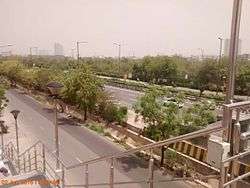
Noida stands at 17th place when it comes to cleanliness among cities in India.[33] The creation of associated physical infrastructure is higher in Noida and Greater Noida.[34] Most of the land in Noida is not very fertile and the agricultural output is low. It is in the flood plains of the Yamuna River on one side and the Hindon River on the other. Many villages are visible from the Noida Expressway, beginning from the Mahamaya flyover to Greater Noida on both sides. One end of Taj expressway terminates on Noida Expressway near the Hindon River and the other at Agra. Up until the 1980s, these villages were flooded every 2–3 years, resulting in people temporarily moving to other places in Noida, and even as far as Mehrauli in Delhi. Noida is also famous for its tall buildings and comes 2nd in India after Mumbai in this parameter.
There is always a huge amount of revenue surplus each year as they are unable to spend the entire amount on development or on maintaining civic amenities. Lease rent and interest from builders are the biggest contributors to Noida’s revenue. Besides, the authority gets huge revenues out of water and property transfer charges. "The Noida authority had deposited ₹3,500 crore as fixed deposits in various banks because of surplus funds. Noida has so much surplus funds with it that it can run the city even if it does not take any taxes from its allottees for 5 years in a row."[35]
A 300 m (980 ft) tall skyscraper named "Spira" is under construction in Noida.[36]
Education
Colleges and Universities
Noida is the location of Uttar Pradesh Technical University and various colleges affiliated to it. It is also the home to many other institutions, including:
- Amity University, Noida
- Government Post Graduate College Noida
- Jaypee Institute of Information Technology
- JSS Academy of Technical Education
- Noida International University
Schools
High schools in Noida include:
- Apeejay School, Noida
- Army Public School Noida
- Assisi Convent School (Noida)
- Bal Bharati Public School
- Cambridge School
- Delhi Public School, Noida
- Fr. Agnel School, Noida
- Kendriya Vidyalaya
- The Khaitan School
- Maharishi Vidya Mandir
- Mayoor School Noida
- Ramagya School
- Ryan International School
- Vishwa Bharati Public School
Economy
.jpg)
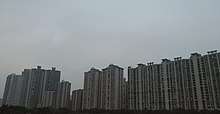
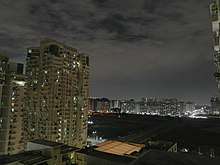
In the last 10 years, Noida has also become a hub for software and mobile app development companies like Microsoft, HCL, Samsung, Barclay's, Agicent, CSC. These companies are contributing to the city's economy with their software product development and service export in foreign currencies. Samsung recently invested INR 5000 crore in Noida, under "make in India" initiative.[37]
Noida is home to India's largest unicorn startup Paytm,[38] a financial services company with multiple ventures including eCommerce, mutual-fund investments, utility bill payments and person-person payments.
Media and entertainment
Noida is a prominent location for the Indian entertainment industry, with many films, television series, news channels, and other media being filmed here. An example of a music company having its headquarters here is T-Series. The city is fast becoming a favourite among directors who want to show a shot of urban culture or college life. According to film producer Rishabh Arora, "Noida has developed a lot in the last decade and feels like home. And it's a great place for outdoor shoots. Films with urban stories become big hits and Noida lends the perfect flavor for urban-themed movies and song sequences. The city has highways, colleges, wide roads, and a good crowd."[39][40] Film City, established by Sandeep Marwah, is a hub for major news channels and studios.
News channels such as News Nation, WION, Zee News, NDTV, TV Today group, Network 18, NewsX, and India TV[41] are situated here and some newspaper company also working in Noida like as Amar Ujala - Noida, Dainik Jagran, Dainik Bhaskar, Rajasthan Patrika, Dainik Prayukti, The Indian Express and TOI. Noida's proximity to Delhi, which is the political hub of the country, makes it an attractive destination for news channels. Commercial activities have also risen in recent years, with a spate of new malls (Mall of India) and multiplexes.
Sports
In 2005, the city hosted the Noida Half-Marathon and the city's maiden international exposure, the Queen's Baton Relay for the Commonwealth Games. The cycling competition for 2010 commonwealth games was held at NOIDA-Greater Noida express way. The Noida Golf Course is situated on the southern end of the city, The Noida Golf 18 hole par 72 Course having a length of 6989 yards length has been assessed by Indian Golf Union Technical Committee. In 2011, Greater Noida hosted the inaugural Formula One Indian Grand Prix at the Buddh International Circuit constructed by Jaypee Group. The circuit is the first of its kind in South Asia.
An international stadium has been built in Sector 21 known as Noida Cricket Stadium with a capacity of around 20,000 spectators, the Noida Stadium Complex houses facilities like dedicated tracks for cycling enthusiasts, golf and football training facilities. The Noida Cricket Stadium Complex consists of Basketball court, Squash court, Table-tennis court, Lawn tennis court, Golf course and Skating rink.[42]
A 50,000 capacity world-class cricket stadium-cum-sports facility with 125 acres land will be built at Noida expressway in Sector 152, which makes it bigger than Feroz Shah Kotla in capacity and area.[43][44]
Transport
Metro
Noida has excellent Metro connectivity.
- The Metro, which was earlier slated to enter Noida in 2011, opened officially on 12 November 2009, 10 months before the Commonwealth Games. Through Delhi Metro, Noida is now connected to Connaught Place, New Delhi and Dwarka sub city, via the Blue Line touching Akshardham Complex, IP Estate, Barakhambha Road, Karol Bagh, Rajendra Place, Rajouri Garden and Uttam Nagar. The same Blue Line connects NOIDA with Vaishali, through the Yamuna Bank interchange station. A part of this link opened on 11 November 2006.
- A metro line named the Aqua Line between Sector-51, Noida and GNIDA Office, Greater Noida is already operational.[45]
- Delhi Metro's magenta line connects Noida and Janakpuri via Botanical Garden, Noida and Janakpuri West Metro Stations[46]
Road
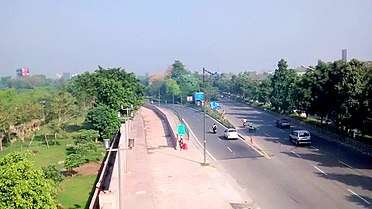
Noida has got roads laid in a grid pattern and due to proper planning, all main roads are 6 lanes wide, arrow straight and are well finished. Noida features three main expressways. One is the DND Flyway, which connects Noida and Delhi, runs across the river Yamuna, and receives heavy patronage from office-goers in the city. The second is the Noida-Greater Noida Expressway and the third is the Yamuna Expressway which connects Greater Noida to Agra via Mathura. The Eastern Peripheral Expressway, Delhi-Meerut Expressway, Upper Ganga Canal Expressway and the Ganga Expressway are the four under construction expressways which will be passing the city. The area adjacent to the NGN Expressway has seen heavy residential development in recent years.
A 6 lane double-decker elevated road is over the MP-II which takes only 5 minutes to cross the whole city. This 4.8 km road starts from Flex crossing and ends at Vishwa Bharti school. Another elevated road from sector 12/22 to sector 12/10-21/21A crossing is going to be built on the MP-I road. Three more elevated roads are planned. Along with these five elevated roads, several underpasses are under construction or approval and all these projects will be completed by 2020. Noida will become the city with the highest number of elevated roads and underpasses in India.
UPSRTC, DTC and private buses ply through various routes in the city. Taxi, auto-rickshaws and cycle rickshaws are available for short-distance transport.
Noida-Greater Noida Expressway
The Noida-Greater Noida Expressway is poised to become a self-sustaining urban pocket in Noida with good infrastructure. This 24.5 km long corridor has attracted real estate Noida Extension investors and buyers with its good infrastructure facilities and connectivity to the other regions of NCR.
This area has emerged as a major growth corridor. Sectors abutting this corridor are 44, 45, 92-94, 96-100, 105, 108, 125-137 and 141-168. These sectors lie towards the south and south-east of Noida.
This area has Metro Rail connectivity which has made this region easily accessible from other parts of NCR. The Metro line in this corridor will has 22 stations, out of which 15 stations are in Noida and 7 in Greater Noida. This line is an extension of Noida City Centre line in sector 32.
The Noida-Greater Noida Expressway is one of the prime development corridors in the country and is unique as connectivity options are already functional or are making good progress.[47]
Rail/Air
Noida is not connected by railways directly, but there are railway stations nearby reachable by road, including Ghaziabad and Anand Vihar. However, New Delhi Railway Station and Old Delhi Railway station (both accessible through Metro) are the main railway stations ones used most often by commuters to reach Noida. The nearest airport is the Indira Gandhi International Airport in Delhi.
In June 2017, the Union Government sanctioned the construction of an international airport in Greater Noida (Jewar) to reduce the traffic of the one in New Delhi.[48]
Bus
Noida has a bus stand at Morna village in Sector 35. There are regular buses to nearby cities like New Delhi, Dehradun, Ghaziabad, Tappal, Khair, Aligarh Bulandshahr, Meerut, Muzaffarnagar, Haridwar etc. Uttar Pradesh Parivahan runs local buses in the city. However, there are plannings to shift the Bus Stand from Morna.
Climate
In summer, i.e. from March to June, the weather remains hot and the temperature ranges from a maximum of 48 °C to a minimum of 28 °C.
Monsoon season prevails during mid-June to mid-September.
The cold waves from the Himalayan region make the winters in Noida chilly and harsh. Temperatures fall to as low as 3 to 4 °C at the peak of winters. Noida also has fog and smog problems. In January, a dense fog envelops the city, reducing visibility on the streets.
| Climate data for Noida | |||||||||||||
|---|---|---|---|---|---|---|---|---|---|---|---|---|---|
| Month | Jan | Feb | Mar | Apr | May | Jun | Jul | Aug | Sep | Oct | Nov | Dec | Year |
| Average high °C (°F) | 21 (70) |
24 (75) |
30 (86) |
36 (97) |
36 (97) |
37 (99) |
35 (95) |
34 (93) |
34 (93) |
35 (95) |
29 (84) |
23 (73) |
31 (88) |
| Average low °C (°F) | 6 (43) |
10 (50) |
15 (59) |
21 (70) |
27 (81) |
29 (84) |
27 (81) |
26 (79) |
25 (77) |
19 (66) |
12 (54) |
08 (46) |
19 (66) |
| Average precipitation mm (inches) | 25 (1.0) |
22 (0.9) |
17 (0.7) |
7 (0.3) |
8 (0.3) |
65 (2.6) |
211 (8.3) |
173 (6.8) |
150 (5.9) |
31 (1.2) |
1 (0.0) |
5 (0.2) |
715 (28.2) |
| Source: Noida Weather | |||||||||||||
Parks and recreation in Noida
The Okhla Bird Sanctuary (OBS)[49] is at the entrance of the city at the point where the Yamuna River enters the state of Uttar Pradesh from the state of Delhi. The Okhla Barrage over the Yamuna has created the unique position of the OBS which attract various species of birds. OBS is among the 466 important bird areas in India. About 324 various bird species are seen in the sanctuary, about 50% of which are migratory birds.
Noida's botanical garden was formed with the aim to turn it into a hub of special and endangered plants, representing the entire country. which is located in Sector 38A of the city, started in 2002. Today, it sprawls across 160 acres, There are around 7,500 plants in the garden.
Scientists are giving a new lease of life to endangered and extinct plant species at the Botanical Garden. A look around the green expanse reveals species like Psilotum Nudum, better known as skeleton fork fern. Considered a "primitive" plant — a descendant of possibly the first group of vascular plants from 400 million years ago — that was widespread during the Devonian and Silurian periods — its name means "bare naked" in Latin as it lacks most of the organs found in plants species that evolved later.[50][51]
Noida's botanical garden is divided into 10 sections. The "medicinal plants" section has an astounding variety of 96 plants and is further divided into eight sections named after the parts of the human body they benefit. For example, the "digestive system" section has aloe vera and Gymnema sylvestre (madhunaashini), which treats diabetes.
The "blood and circulation" section has Withania Somnifera (Ashwagandha) and Aristolochia Indica (Isharmul) - blood purifiers. The "musculo-skeletal" section has Cissus Quadrangularis (Hadjod); "skin disease" section has Plumbago Zeylanica (Chitarak) which cures leucoderma.
Noida's botanical garden has a large fruit section which has many varieties of mango, pomegranate, lemon, pear, plum, mulberry, etc., besides their speciality the black guava (kaala amrud). The woodland section is equally impressive with trees like Sapindus Emarginatus (Reetha), Pterocarpus marsupium (Sandalwood), Dalbergia sissoo (Sheesham wood), and Tectona Grandis (Teakwood).[52]
Notable people
Art, Entertainment and Television
- Harsh Nagar, Bollywood actor.[53]
- Ram Awana, Indian film and television actor
Politics
- Nawab Singh Nagar, politician[54]
- Tejpal Singh Nagar, politician[54]
- Mahesh Sharma, politician
- Pankaj Singh, politician, MLA for Noida
Sports
- Parvinder Awana, Indian cricketer
- Varun Singh Bhati, para high jumper
- Shivam Mavi, Indian cricketer
- Robin Singh, footballer
Villages in Noida City
Noida originally consisted of around 81 villages, but now comes under the Gautum Buddh Nagar district of Uttar Pradesh.[55]
Still, Noida villages lack in permanent postal and individual address but according to officials, the homes in villages will be soon mapped using aerial imagery captured by drones designed by North East Centre for Technology Application and Reach (NECTAR), an autonomous society set up under the Union government's department of science and technology. These maps will also provide crucial information about rural areas in an emergency. Officials said it will take almost a year to complete mapping and allotting address to all 81 villages.
With houses getting mapped and being allotted a formal address in Noida villages, procuring information on land rights, development plans, etc. will become easier. "Easily available maps will also be helpful in advancing development plans and settling disputes over bordering parcels of land. Mapping will also ease land transfers, by creating reliable maps and title documents."[55]
See also
References
- "सुहास एल वाई बने नोएडा के नए डीएम, BN सिंह को किया गया राजस्व परिषद से अटैच". Hindustan (in Hindi). New Delhi. 30 March 2020. Retrieved 30 March 2020.
- "Census of India Search details". censusindia.gov.in. Retrieved 10 May 2015.
- "52nd REPORT OF THE COMMISSIONER FOR LINGUISTIC MINORITIES IN INDIA" (PDF). Ministry of Minority Affairs. Archived from the original (PDF) on 25 May 2017. Retrieved 4 January 2019.
- Patra, Pratyush (14 July 2015). "Vibha Chibber: We moved to Noida as it is a planned city". The Times of India. Retrieved 13 August 2017.
- "Urban Agglomerations/Cities having population 1 lakh and above" (PDF). Office of the Registrar General and Census Commissioner of India. Ministry of Home Affairs, Government of India. p. 3. Retrieved 3 October 2017.
- "New Okhla Industrial Development Authority, Uttar Pradesh, India". noidaauthorityonline.in. Retrieved 31 July 2020.
- "Dr. Mahesh Sharma - Ministry of Culture". indiaculture.nic.in.
- Noida’s first MLA has his task cut out. Hindustan Times. Retrieved on 21 July 2013.
- "Mumbai wins the Best City Award 2015". english.
- "ABP News awards Noida city for housing and best city in Uttar Pradesh". Ten News Network. 11 March 2014.
- Seth, Dilasha (9 August 2012). "Noida replaces Mumbai as second best realty destination: Report". Business Standard.
- "Authority to make atlas to bring Noida on tourist map". The Times of India. 4 April 2015. Retrieved 3 October 2017.
- Aradhak, Purusharth (6 July 2015). "'Noida is country's greenest city, drive to push cover'". The Times of India. Retrieved 3 October 2017.
- "U.P. INDUSTRIAL AREA DEVELOPMENT ACT – 1976 (U.P. Act Number 6, of 1976)" (PDF). Noida Authority. 1976. Archived from the original (PDF) on 12 August 2017. Retrieved 13 August 2017.
- "List of Operational SEZ of India as on 07.09.2017" (PDF). Ministry of Commerce and Industry. 7 September 2017. Retrieved 15 October 2017.
- Purusharth Aradhak, "Infrastructure projects to get a boost with Noida Authority's Rs 8,000 crore budget", Times of India, 27 January 2014
- "Noida Religion Data - Census 2011". www.census2011.co.in.
- "Contact Us - Noida Authority Online". Noida Authority. Retrieved 12 August 2017.
- PTI (13 July 2019). "Ritu Maheshwari is new CEO of Noida Authority". The Financial Express. Retrieved 25 July 2019.
- "CONSTITUTIONAL SETUP". Government of Uttar Pradesh. Retrieved 30 August 2017.
- Maheshwari, S.R. (2000). Indian Administration (6th ed.). New Delhi: Orient Blackswan Private Ltd. pp. 563–572. ISBN 9788125019886.
- Singh, G.P. (1993). Revenue administration in India: A case study of Bihar. Delhi: Mittal Publications. pp. 26–129. ISBN 978-8170993810.
- Laxmikanth, M. (2014). Governance in India (2nd ed.). Noida: McGraw Hill Education. pp. 5.1–5.2. ISBN 978-9339204785.
- "Role and Functions of Divisional Commissioner". Your Article Library. 6 January 2015. Retrieved 20 August 2017.
- "Office of the Divisional Commissioner, Meerut Division". Office of the Divisional Commissioner, Meerut. Retrieved 13 August 2017.
- Maheshwari, S.R. (2000). Indian Administration (6th ed.). New Delhi: Orient Blackswan Private Ltd. pp. 573–597. ISBN 9788125019886.
- Laxmikanth, M. (2014). Governance in India (2nd ed.). Noida: McGraw Hill Education. pp. 6.1–6.6. ISBN 978-9339204785.
- Singh, G.P. (1993). Revenue administration in India: A case study of Bihar. Delhi: Mittal Publications. pp. 50–124. ISBN 978-8170993810.
- "Powers Of District Magistrate in India". Important India. Archived from the original on 16 August 2017. Retrieved 20 August 2017.
- "Police gets more powers in U.P., commissioner system implemented in Lucknow, Gautam Buddha Nagar". The Hindu. 13 January 2020. ISSN 0971-751X. Retrieved 19 July 2020.
- "List of Officers posted at G.B. Nagar, Uttar Pradesh (Noida Police)". uppolice.gov.in. Retrieved 19 July 2020.
- "Alok Singh is Noida's first CP after district upgraded to commissioner system". Hindustan Times. 13 January 2020. Retrieved 19 July 2020.
- "Article view". Epaper.amarujala.com. 13 May 2010. Retrieved 16 July 2010.
- The uneven growth in NCR. Financialexpress.com. Retrieved on 21 July 2013.
- "Noida: Gold mine of Uttar Pradesh". Hindustan Times. 3 December 2014. Retrieved 3 October 2017.
- "At 300 metres, Noida's tallest tower will be ready in 2 years". Hindustan Times. 18 August 2018.
- Phartiyal, Sankalp. "Samsung opens world's largest phone factory in India". U.S. Retrieved 19 July 2018.
- "India's biggest unicorn Paytm commits $1.4 billion to penetrate deeper into hinterland; raises funding". The Financial Express. 25 November 2019. Retrieved 7 March 2020.
- Lal, Niharika (9 January 2015). "CM to launch trailer of film shot in Noida at Saifai Mahotsav". The Times of India. Retrieved 3 October 2017.
- Lal, Niharika (20 March 2015). "Noida’s Bollywood calling: Lending backdrop to urban stories". The Times of India. Retrieved 3 October 2017.
- "Noida News - Noida Latest News | Latest Updates of Noida News Today on NYOOOZ".
- "Noida stadium to turn into pedallers' paradise". The Times of India. 12 April 2012. Retrieved 3 October 2017.
- Keelor, Vandana (4 June 2015). "Cricket stadium bigger than Kotla planned in Noida". The Times of India. Retrieved 3 October 2017.
- "नोएडा में नया वर्ल्ड क्लास क्रिकेट स्टेडियम जल्द" [New world class stadium in Noida soon]. Navbharat Times. 4 June 2015. Retrieved 3 October 2017.
- Sinha, Snehil (13 May 2018). "Noida-Greater Noida Metro aqua line may begin by September". Hindustan Times.
- Pillai, Soumya (21 May 2018). "It's official: The Magenta Line of Delhi Metro". Hindustan Times.
- "Noida - Greater Noida: Good living quotient". indianexpress.com.
- "New airport to come up in Greater Noida's Jewar as Centre clears proposal". Hindustan Times. 24 June 2017. Retrieved 16 August 2017.
- "Okhla Bird Sanctuary". obs-up.com. Retrieved 22 December 2019.
- Alam, Shafaque (12 February 2014). "New orchids bring diversity to Botanical Garden flora". The Times of India. Retrieved 3 October 2017.
- Keelor, Vandana (1 August 2014). "Noida's botanical garden a 'Jurassic Park' for plants". The Times of India. Retrieved 3 October 2017.
- Adak, Baishali (18 July 2012). "A garden to heal". Deccan Herald. Retrieved 3 October 2017.
- "Harsh Nagar on a roll". The Hindu. 21 July 2011. Retrieved 22 December 2019.
- Sohil Sehran (12 March 2017). "Greater Noida: BJP's Tejpal Singh Nagar wins the battle of the Gujjars in Dadri". Hindustan Times. Retrieved 16 January 2019.
- Keelor, Vandana (22 April 2015). "Rural Noida to enter digital domain". The Times of India. Retrieved 3 October 2017.
External links
| Wikimedia Commons has media related to Noida. |
| Wikivoyage has a travel guide for Noida. |


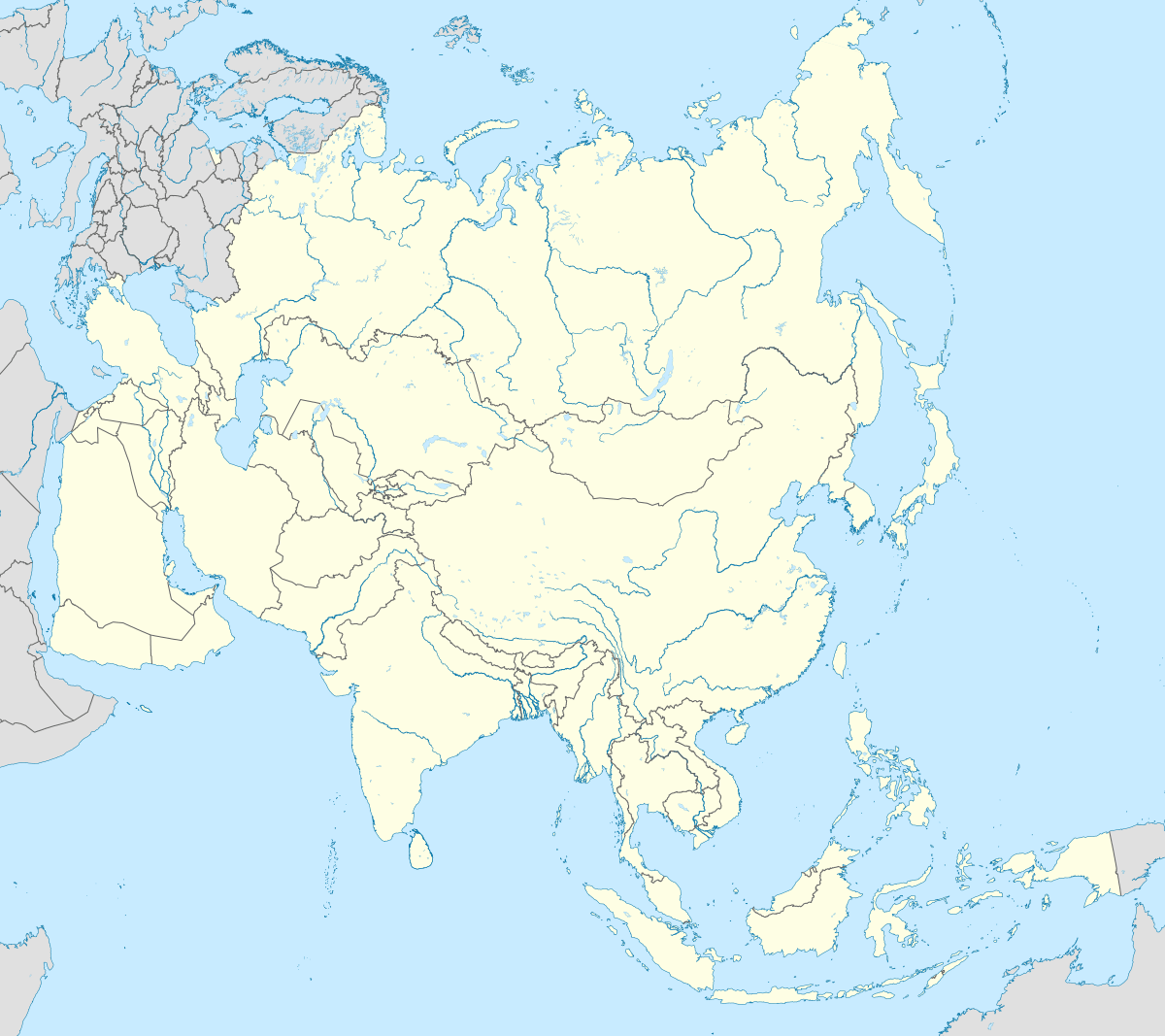
.jpg)
